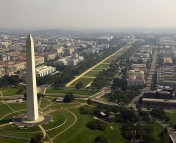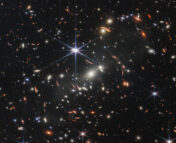Astrobites is again liveblogging AAS! In order to avoid inundating our readers’ RSS feeds, we’ll be updating this post with short paragraphs about the talks we’ve heard and posters we’ve seen. So keep checking back throughout Monday morning!
-The Astrobites Team
8:00am – Welcome Address
Welcome to the AAS meeting! President David Helfand begins the meeting by welcoming everyone to AAS. He mentions the great work amateurs can do in astronomy (one of the few scientific fields where this is true!) and discusses how to become involved in the AAS.
There are a record number of talks this week, a series of talks aimed towards amateur astronomers, public policy, and career development.
And on to the first talks!
Kavli Lecture: Hubble Deep Field & Its Legacy, Robert Williams (STScI)
To understand how we got to the present, we have to peer into the past. Early observations with the Hubble telescope suggested that galaxies looked very different at high redshift than they do today, for example in galaxy cluster 3C 324. This prompted a team of astronomers to propose an observational campaign using Hubble to look at the distant Universe. They decided they would observe a blank field which became known as the Hubble Deep Field. But how could they obtain distances to the galaxies in the field? The objects were faint, so spectroscopic redshifts were expensive. This led to the development of photometric redshifts, estimates of the distances to galaxies based only on their colors. Using photometric redshifts allowed astronomers to build the Madau plot, the measurement of the star formation history of the Universe as a function of cosmic time, to study the morphological evolution of galaxies and to find many other exciting applications in cosmology and galaxy formation. Many Hubble deep surveys followed!
Christopher Britt is using the Chandra Galactic Bulge Survey is helping to look for low mass X-ray binaries in quiescence in the galactic bulge. This survey is finding many objects such as dwarf novae that are not what they are looking for. He is following up many of these objects with smaller telescopes such as SMARTS. A number of these seem to be undergoing outbursts. The goal is to understand how often these outbursts occur.
Extrasolar Planet Characterization & Theory
Lauren Weiss later presented a mass-radius relation based on those new mass measurements and the Kepler radius measurements. Continuing the Kepler theme, David Sliski discussed his work using Kepler photometry to estimate the false positive probability for planet host stars.
In a different session, Zachory Berta-Thompson present transit light curves of the Mini-Neptune GJ 1214b from Magellan and Hubble. He emphasized that the appearance of star spots in some of the light curves could be used to estimate the inclination of the planet’s orbit relative to the star’s spin axis.
Kevin Schlaufman explained how tidal forces can tear apart short-period planets orbiting evolved stars. After Dr. Schlaufman’s talk, Avi Mandell discussed sophisticated methods to remove systematics from Hubble observations of hot Jupiters. Dr. Mandell’s analysis revealed that the depth of the water band for one hot Jupiter (WASP-17) is much smaller than expected.
Switching gears to theory, Gongjie Li presented a new mechanism to explain why some hot Jupiters orbit “backwards” around their stars in the opposite direction of the star’s spin axis. Li proposed that a “backwards” hot Jupiter could be produced by tidal forces if the system initially contained two close bodies in an eccentric orbit and a third body orbiting farther out.
Going back to observations, Rob Zellem presented a beautiful Spitzer light curve covering the whole orbit of the hot Jupiter HD 209458b. Zellem stated that the position and brightness of the bright spot agrees well with model predictions by Showman et al. (2008). Finally, Julien Lozi described the low-order wavefront sensor for the proposed EXCEDE (EXoplanetary Circumstellar Environments and Disk Explorer) mission to search for dust within the habitable zones of nearby stars.
10:15 am — Press Conference #1: Cosmic Explosions
Scott Ransom: A millisecond pulsar in a stellar triple system
Ransom reported the discovery an exciting new system consisting of three stellar relics: a millisecond pulsar (a type of neutron star) and two white dwarfs. This rare system was discovered in a survey using the Green Bank radio Telescope. Millisecond pulsars, so named because they have rotation periods of thousandths of a second, are extremely precise clocks. As the system orbits, the arrival times of the pulses modulate thanks to the changing distance of the pulsar, and these delays can be measured to accurately determine orbital periods and masses of the compact objects. Newtonian gravity plus special relativity are able to model the system quite well; future tests of General Relativity are also possible thanks to the extremely strong gravity in neutron stars.
Remy Indebetouw: Dust factory in SN1987A

SN 1987A: Hubble (green), Chandra x-ray (blue), and ALMA submillimeter (red) observations. The ALMA data reveal the presence of a significant amount of dust at the remnant’s center.
Dust is key to star formation — it promotes the formation of molecules which then cool gas and allow gravity to promote collapse. It is thus important to the evolution of galaxies and the Universe. Cosmic dust is thought to be generated primarily in supernovae, but has not been previously detected in large quantities when we look for it in supernova remnants. The newly commissioned Atacama Large (sub)Millimeter Array (ALMA) in Chile targeted the explosion site of the nearby SN 1987A (in the 50 kpc distant Large Magellanic Cloud) and discovered a significant reservoir — 0.25 solar masses — of dust in the center of the remnant (see figure at right). If other supernovae produce similar amounts of dust, this could solve the mystery of where most of the cosmic dust came from.
Teddy Cheung: First measurement of gravitational lensing in gamma rays
The Universe is full of interesting, exotic, and rare things. Blazars come from supermassive black holes at the centers of galaxies with their polar jets favorably aligned toward our line of sight. Gravitational lensing is a phenomenon in which a background source is split into multiple images due to the bending of its light by a foreground mass (such as a galaxy or galaxy cluster). Thanks to the action of Einstein’s general relativity, the light that travels along different paths arrives at Earth at different times. If the background source is variable, this will manifest as variations occurring in the different images at different times. Cheung presented the study of an object that falls into both of these rare categories: a gravitationally lensed blazar. Two separate images of the same object are visible in previous high-resolution radio studies. The Fermi gamma ray telescope monitored the brightness variations in this blazar over several months and found an 11.5 day light echo — thereby comprising the first gamma ray observations of a lensed blazar.
Kepler Astrophysics:
Fabienne Bastien told us about her efforts to harness stellar “noise” in efforts to find and characterize exoplanets. She derived three ways the quantify stellar variability (which is noise if you’re looking for exoplanets!) and found that they traced stellar parameters well. For example, the short term photometric variability she called “flicker” tells you singing about the stars surface gravity! Currently, she’s working on measuring chromospheric activity (which traces surface magnetic fields) for Kepler stars, finding some really intriguing populations of stars… Stay tuned!
Plenary Talk
Alyssa Goodman’s plenary talk has got to have taken the prize of “most tweeted talk.” Her talk was about data visualization in astronomy. Her first example: Galileo’s Sidereus Nuncias, where Galileo depicting the motion of the unknown points of light moving around Jupiter (it’s moons!). She showed both Galileo’s originally drawing, and how it looks in World Wide Telescope, an astronomy visualization platform. Alyssa talked about the history, and future of publication. Galileo published a book about his findings, and today we publish papers (she showed us the first ApJ, in 1895, which looks a lot like today’s…) Alyssa and her collaborators got a 3D, interactive figure into a journal and told us ApJ was ready for our interactive figures. The next step: linking data between figures. Alyssa highlighted several efforts on linked, interactive data: the COMPLETE survey, Chris Beaumon’ts python package GLUE, the web-based interactive data visualization package d3po.





This is such a useful set of posts – thank you so much. I’m fascinated to know what’s going on at the conference and am checking in to astrobites routinely to get my update.
Keep up the excellent work!
Margarita
Glad you’re finding them useful! We’re having a lot of fun writing the updates, it’s great to hear that you’re enjoying them!
Thanks for the updates. It’s nice to get reports like this from meetings I can’t attend. One comment/question though. It looks like there’s a typo in the section of Scott Ransom’s presentation. It says, “Millisecond pulsars … have rotation periods of millionths of a second”, but that should be thousandths of a second, correct?
Oops, you caught us! That’s right.